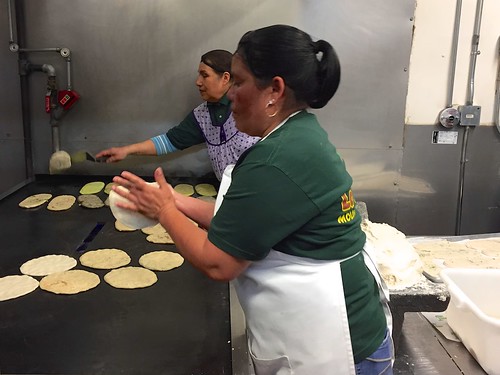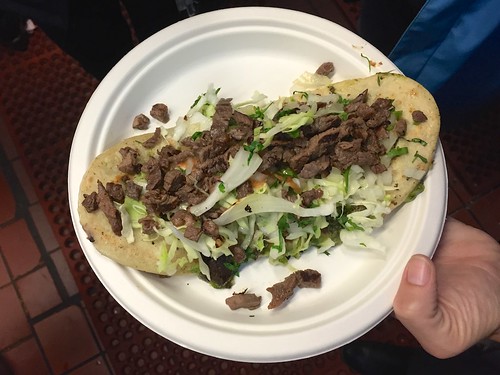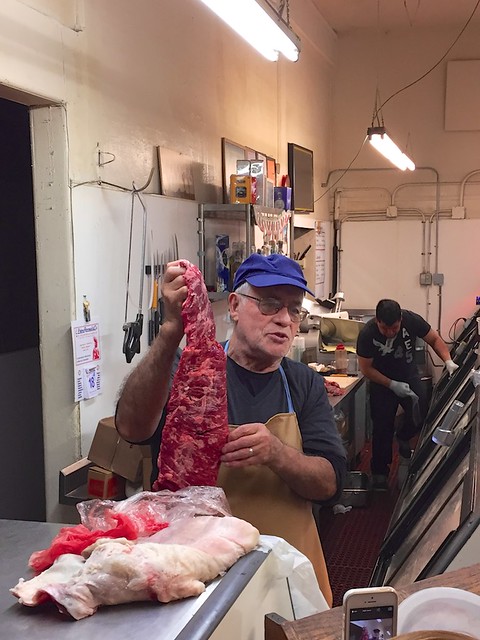Things I learned from Rick Bayless
Disclosure: I was compensated by Negra Modelo to attend this event, post about it on social channels, and write this blog post.
I'm not going to mince words about it: Sometimes being a food blogger has pretty awesome perks. Like when your go-to Mexican beer approaches you with an opportunity to take a culinary tour of the Mission District with Rick Bayless, and pay you for the privilege. Twist my arm.
We kicked our tour off at a well-known "Mexicatessen" on 24th street, a place I know well thanks to my affiliation with Edible Excursions. (Note: Due to some regulations, I cannot name the places we went to. I know, weird.) This place receives enormous amounts of dry corn on a roughly biweekly basis, which they grind and mix with water and lime (calcium hydroxide, not the fruit) in a process called mixtamalization. This unlocks the bioavailability of nutrients in the corn. They then use this mixture, called masa mixtamalisada, to make fresh tortillas, huaraches, sopes and other delicacies -- all by hand. This is my go-to spot to buy fresh corn tortillas, crema salvadoreia, and fabulous salsas.

(Sidebar: Come take our tours in San Francisco, Oakland or Berkeley! If you book a private tour for a group of 8 or more, you get a free tour for two for yourself. I'm just one of a whole fleet of awesome guides with Edible Excursions.)
Piping-hot huarache stuffed with cheese and herbs, topped with grilled flank steak and cabbage? Don't mind if I do. (Washed down with Negra Modelo, of course.)

Speaking of flank steak, our next stop was a nearby meat market, family-owned for more than 40 years. The second-generation owner, Salvador Vazquez, explained that until the '70s, the beef commonly used for carne asada was not widely available in America outside Latino markets. In the mass market, it was usually thrown in with other less desirable cuts for ground beef, but in Mexico, it's treasured for its intensely beefy flavor. A friend observed Vazquez carving out the section of the cow containing a few cuts of thin, flat steaks for use.

He asked Vazquez what these cuts were called, and for lack of a good translation called it "flap meat." The friend asked him to show a colleague, who turned out to be a rep with IBP, and before long flap steak became available as a grocery store cut across the country. What was once considered all but a disposable cut is now marketed as flank and skirt steak, and for a premium price at that.
After that we headed to another popular Mexican restaurant in SoMa for the main event. All the while, Rick Bayless was with us, rocking a white handlebar moustache that he occasionlly twirled nefariously like Snidely Whiplash.

We settled in, nibbled on passed hors d'oeuvres, and of course enjoyed a little more Negra Modelo. Off in one corner stood a quirky vending machine that impelled you to send fill-in-the-blank tweets, after which you were rewarded with a prize.

Being a bunch of swag junkies, we were all over that shit. Along with an array of branded bottle openers, cutting boards, cable octopuses and whatnot were tins in mesh bags that held a keyword, and when one of these was dropped, Bayless got up to speak on the subject: Avocados, chilies and onions. And speak he did. Bayless' depth of knowledge on all things Mexican cuisine seemingly knows no bounds, and he rattled on at great length. These are just a few of the things of interest I noted, some new to me:
Avocados
When testing for ripeness, press the bottom of the avocado. It's the last place where it ripens, so if it yields to gentle pressure, it's ready.
Brown spots and other blemishes are not necessarily a problem. If they have no structure or are not too mushy, simply mash them in with the avocado. You'll never know the difference.
Americans have been misled to think that the only way to keep avocado from browning is to add lots of lime juice. This will keep browning at bay, but it bludgeons the flavor of the fruit. Use just a small squeeze, and keep the avocado cold. If possible, put the bowl on ice. Warmth is the greatest enemy to fresh avocado. And then eat it, sooner than later.
Chilies
Of fresh chilies, the two major players in Mexican food are jalapeños and serranos. Serranos are reliable, consistent peppers with good heat. Jalapeños are wildly inconsistent, alternately mild or intensely fiery.
Poblanos are also popular, but not for heat. Consider them the green bell pepper of Mexico.
When using fresh chilies, it's not the seeds that add heat; it's the veins. If you carefully trim the veins away, the flesh will be mild. That said, the veins do add flavor. (I heard recently that the membranes of chilies, much like the gelatinous goo around seeds in tomatoes, are high in flavor-enhancing glutamates.)
Most chilies, including jalapeños and serranos, are in the same family, capsicum annuum. Habaneros and their like, including Scotch bonnet and the like, are capsicum havanense.
The most commonly used dried chilies in Mexican food are the ancho and pasilla. The ancho is a dried poblano, and the pasilla is the dried version of the chilaca, a long, narrow pepper. The two have complementary flavors, and are commonly used together.
However, domestically anchos are often labeled as pasilla, or sometimes ancho-pasilla. This is because the people of the state of Michoacán uniquely called pasillas anchos, and when large numbers of Michoacanos emigrate to California, they took that nomenclature with them. It pays to know which is which.
Onions
White and yellow onions are not interchangeable. Yellow onions have a more assertive flavor, and are best cooked. White onions are fresh and crisp, and good for raw preparations like salsa and guacamole.
All onions have sulfuric compounds that, when cut, create sulfuric acid, which makes us cry. To get rid of that, simply rinse them in water for a few minutes. This is called desflemar la cebolla, or to "deflame the onion."

